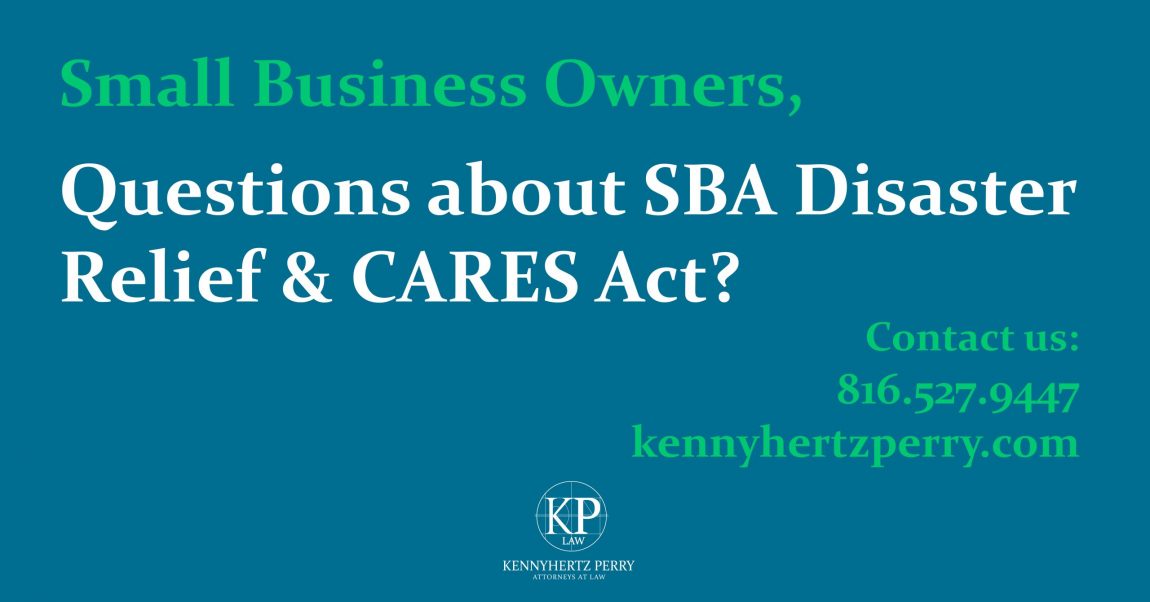
Small Business Relief Loans-CARES Act v. SBA Disaster Relief
With COVID-19 causing serious disruption to US businesses, a number of programs have been created to assist small businesses with their ongoing expenses. Below is a summary of two loan programs that all small businesses should consider: the CARES Paycheck Protection Program and SBA Economic Injury Disaster Loans. Please reach out to us if you need assistance navigating these programs.
CARES PAYCHECK PROTECTION PROGRAM (“PPP Loans”)
- Application Process: The PPP loans will be provided by private banks, credit unions, and lenders throughout the United States. A sample application that lenders will use has been released by the SBA. You will need to provide the lender with payroll documentation for the past year, and documentation that verifies your mortgage, rent, and utility payments. You must also certify that current economic uncertainty makes the loan necessary to support your ongoing operations.
- Who Can Apply: All businesses with 500 or fewer employees can apply. This includes nonprofits, veterans organizations, Tribal business concerns, sole proprietorships, self-employed individuals, and independent contractors.
- Application Date: Small businesses and sole proprietorships can apply and receive loans starting April 3. Independent contractors and self-employed individuals can apply starting April 10.
- Loan Amount: 2.5 times your average monthly payroll costs for the one year preceding the loan origination date. So, if you averaged $10,000 in payroll costs each month for the past year, you can obtain a $25,000 PPP loan.
- Interest Rate: 0.5%. This interest will apply only to the balance of the PPP loan which is not forgiven. All payments are deferred for 6 months (interest accrues during this time) and the loan is due in 2 years.
- Loan Forgiveness: Eligible for loan forgiveness for 8 weeks from the loan origination date, only for amounts spent on payroll costs, rent, mortgage interest, and utilities. Because of the number of loans expected to be given, it is anticipated that not more than 25% of the forgiven amount may be for non-payroll costs. So, if you spend 50% of the loan on payroll and 50% on rent, only 75% of the loan will be forgiven. Loan forgiveness may also be reduced if you decrease your full-time employee headcount or if you decrease salaries and wages by more than 25% for any employee that made less than $100,000 in 2019. However, employers will still be eligible for forgiveness if they restore their full-time employment and salary levels by June 30, 2020. You will submit a request for forgiveness to the lender. The request will include documents that verify the number of full-time equivalent employees and pay rates, as well as the payments on eligible mortgage, lease, and utility obligations.
- Personal Guarantee/Collateral: No personal guarantees or collateral required.
- Authorized Loan Use: Payroll costs, rent, mortgage interest, and utilities. Loan money cannot be used to compensate an employee or contractor in excess of an annual salary of $100,000.
- Miscellaneous:
- Payroll costs include compensation, paid leave, severance, group health benefits including premiums, retirement benefits, and state/local employment taxes.
- Your business must have been in operation prior to February 15, 2020.
- No annual or guarantee fees.
- Available until June 30, 2020.
- Contact your local bank, credit, or lender about applying.
SBA ECONOMIC INJURY DISASTER LOANS (“EIDLs”)
- Lender: The SBA serves as the direct lender of EIDLs. No private banks or lenders are involved.
- Loan Amount: SBA will offer you an amount based on your “substantial economic injury” related to COVID-19 going back to January 31, 2020. The maximum loan is $2,000,000.
- Interest Rate: 3.25% with for-profit businesses. 2.25% with non-profit businesses.
- Loan Forgiveness: Applicants may receive a $10,000 emergency advance (within 3 days of applying), which can be forgiven if spent on paid leave, maintaining payroll, increased costs from supply chain disruption, rent, mortgage interest, or repayment of unmet obligations from lost revenue. This amount will be deducted from any loan forgiveness under the PPP loan program.
- Personal Guarantee/Collateral: No personal guarantees required for EIDL loans up to $200,000. The SBA will provide unsecured EIDL loans under $25,000 and require some form of collateral for EIDL loans over $25,000.
- Authorized Loan Use: Working capital, including payment of fixed debts, payroll, accounts payable, and additional bills that you cannot pay because of the impact of COVID-19.
- Miscellaneous:
- EIDLs provide long term repayments, up to a maximum of 30 years.
- You must demonstrate an ability to repay the EIDL loan, based principally on your credit score.
- Your business must have been in operation for over one year.
- Available until December 31, 2020.
- Visit the SBA disaster loan website to apply: https://www.sba.gov/disaster-assistance/coronavirus-covid-19
Are you a small business?
Most likely, yes. If you have less than 500 employees, you should be deemed a small business for either a PPP loan or EIDL. Depending on your NAICS code, your businesses may still qualify as a small business if it has more than 500 employees. You can find out for sure at this link: https://www.sba.gov/size-standards/
Can you apply for both PPP loans and EIDLs?
Yes, you can apply for and obtain both types of loans. However, you cannot use proceeds from these loans for the same purpose. In addition, if you have already received an EIDL, you can seek to re-finance the EIDL under the PPP loan program.
*The choice of a lawyer is an important decision and should not be based solely upon advertisements.
